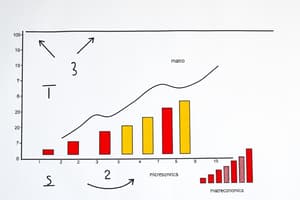Podcast
Questions and Answers
What does the concept of scarcity imply in economics?
What does the concept of scarcity imply in economics?
- Individuals can satisfy all their wants easily.
- Resources are limited, leading to the need for choice. (correct)
- Resources are unlimited and do not require allocation.
- Economic systems do not face resource limitations.
Which branch of economics focuses on the overall economy and aggregate indicators?
Which branch of economics focuses on the overall economy and aggregate indicators?
- Normative Economics
- Microeconomics
- Macroeconomics (correct)
- Behavioral Economics
What is the main characteristic of a mixed economy?
What is the main characteristic of a mixed economy?
- Strict adherence to free-market principles.
- Combination of capitalism and socialism. (correct)
- Complete state ownership of resources.
- No government intervention in markets.
What does the law of demand state?
What does the law of demand state?
How is price elasticity of demand defined?
How is price elasticity of demand defined?
Flashcards are hidden until you start studying
Study Notes
Key Concepts in Economics
Basic Definitions
- Economics: The study of how individuals, businesses, and governments allocate resources.
- Scarcity: Limited resources versus unlimited wants, necessitating choice.
- Opportunity Cost: The value of the next best alternative forgone when making a choice.
Branches of Economics
- Microeconomics
- Focuses on individual and business decision-making.
- Analyzes supply and demand, market structures, and consumer behavior.
- Macroeconomics
- Studies the economy as a whole.
- Examines aggregate indicators like GDP, unemployment rates, and inflation.
Economic Systems
- Capitalism: Private ownership of resources, market-driven economies.
- Socialism: Collective or governmental ownership of resources, aims for equal distribution.
- Mixed Economy: Combines elements of capitalism and socialism; most modern economies.
Key Economic Principles
- Supply and Demand: Determines prices in a market economy.
- Law of Demand: Price increase leads to quantity demanded decrease, and vice versa.
- Law of Supply: Price increase leads to quantity supplied increase, and vice versa.
- Elasticity: Measures responsiveness of quantity demanded or supplied to price changes.
- Price Elasticity of Demand: Sensitive demand to price changes; can be elastic (>1) or inelastic (<1).
Market Structures
- Perfect Competition: Many firms, identical products, easy market entry/exit.
- Monopoly: Single firm controls the market, significant barriers to entry.
- Oligopoly: Few firms dominate, interdependent pricing and output decisions.
- Monopolistic Competition: Many firms, differentiated products, some market power.
Economic Indicators
- Gross Domestic Product (GDP): Total value of goods/services produced in an economy.
- Unemployment Rate: Percentage of the labor force that is unemployed.
- Inflation Rate: Rate at which general prices for goods and services rise.
Fiscal and Monetary Policy
- Fiscal Policy: Government spending and taxation decisions to influence the economy.
- Tools include government budgets and public spending.
- Monetary Policy: Central bank actions to control the money supply and interest rates.
- Tools include interest rates, reserve requirements, and open market operations.
International Economics
- Trade: Exchange of goods/services across borders; includes concepts of comparative advantage.
- Exchange Rates: Value of one currency for the purposes of conversion to another.
- Globalization: Increased interconnectedness of economies through trade and investment.
Important Theories
- Classical Economics: Emphasizes free markets, competition, and self-regulation.
- Keynesian Economics: Advocates for government intervention to manage economic cycles.
- Supply-Side Economics: Focuses on boosting supply through tax cuts and deregulation.
Conclusion
Economics is a broad field encompassing various theories, principles, and applications that help explain how resources are allocated and how economies function. Understanding micro and macroeconomic concepts is crucial for analyzing individual behaviors and overall economic performance.
Basic Definitions
- Economics studies resource allocation among individuals, businesses, and governments.
- Scarcity arises when limited resources clash with unlimited human wants, leading to necessary choices.
- Opportunity Cost represents the value of the next best alternative that is given up when a decision is made.
Branches of Economics
- Microeconomics focuses on the decision-making processes of individuals and businesses, analyzing components like supply and demand, market structures, and consumer behavior.
- Macroeconomics examines the economy at large, considering aggregate measures such as Gross Domestic Product (GDP), unemployment rates, and inflation.
Economic Systems
- Capitalism is characterized by private ownership of resources and market-driven economies, emphasizing economic freedom.
- Socialism features collective or governmental ownership of resources, aiming for equitable distribution among the populace.
- A Mixed Economy integrates both capitalism and socialism, allowing for a combination of private enterprise and government intervention; prevalent in most modern nations.
Key Economic Principles
- Supply and Demand are fundamental concepts that dictate pricing within market economies.
- The Law of Demand asserts that an increase in price generally results in a decrease in the quantity demanded, while a price decrease increases demand.
- The Law of Supply states that higher prices encourage greater supply, while lower prices lead to less supply.
- Elasticity assesses how responsive the quantity demanded or supplied is to price fluctuations.
- Price Elasticity of Demand gauges the sensitivity of demand to changes in price; it can be classified as elastic (greater than 1) or inelastic (less than 1).
Studying That Suits You
Use AI to generate personalized quizzes and flashcards to suit your learning preferences.




